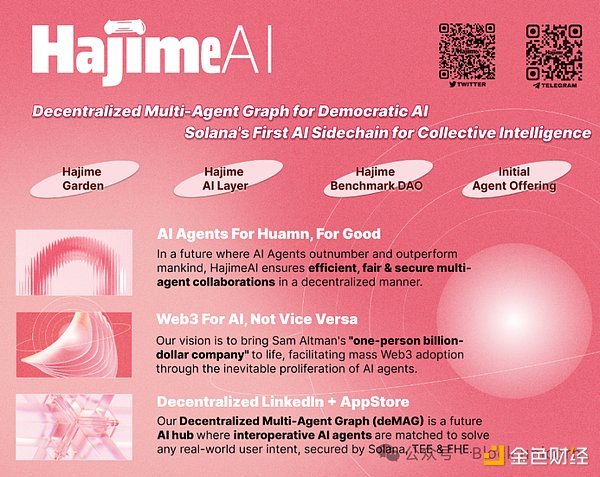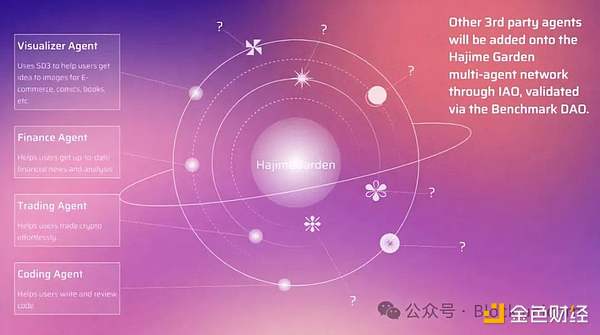Author: Block unicorn
Artificial intelligence (AI) is leading us into the fourth industrial revolution and opening a new era of human development. Although industry giants such as OpenAI's ChatGPT, Meta's Llama, and Google's Gemini have delivered their own excellent AI answers and led the global AI wave, there is still a key problem in AI that needs to be solved: How can we democratize AI and accelerate its popularity? The answer is AI Agent.
AI Agents are pioneers in the field of AI. They are complex software built on advanced large language models (LLMs) that can handle a variety of tasks in the real world. For example, these agents can perform operations autonomously or semi-autonomously, from scheduling appointments to providing customer support.
Since the launch of Stanford AI Virtual Village and MIT AI Town, AI Agent has become more and more popular as a carrier for AI to enter thousands of households. It is conceivable that in the future, each of us will have a large number of AI Agents to serve us, just like people now have a considerable number of mobile apps on their phones. However, in order for AI Agents to truly replace clumsy mobile apps, we must overcome some major obstacles:
1. First, current AI Agents often operate in the form of islands, lacking the collaboration of multiple AI agents required by users and enterprises, and are difficult to serve complex scenario requirements.
2. In addition, many emerging AI Agent projects have difficulty in financing and it is difficult to achieve the right product-market fit in a timely manner. This is particularly evident today when the AI industry focuses on large-scale model competitions led by large companies, and many good AI products that serve a single niche scenario do not receive the attention they deserve.
3. At the same time, the competitive advantage of top AI agents often relies on their unique expertise and private data, which makes them hesitant to join or launch a multi-agent network based on the centralized architecture of Web2.
This year's Solana Renaissance Hackathon winning project HajimeAI is preparing to face these challenges head-on using crypto-native technology and bring a new direction to the development of AI Agents with the paradigm of Web3. Inspired by OpenAI CEO Sam Altman's vision of "one person creating a billion-dollar company", the HajimeAI team is committed to shaping a decentralized future where collaborative AI agents collaborate to form a decentralized Multi-Agent Graph (deMAG) to meet the user intent needs of the real world.
The underlying architecture of HajimeAI is the AI function extension layer of the Solana L1 blockchain. As the first scalability solution on Solana specifically built for multi-agent collaborative graphs, HajimeAI not only has the first Solana sidechain Hajime AI Layer that is specifically optimized for AI operations, it is also a powerful computing engine for multi-agent workflows that can meet the billions of processing needs brought about by the explosive growth of multi-agent solutions in the future.
At the same time, leveraging Solana's strong security, HajimeAI allows anyone to issue on-chain AI Agent assets and increase the user base through the abundant liquidity of the Solana main chain. HajimeAI is committed to strengthening the diversification of the Solana ecosystem and preparing for the upcoming large-scale Web3 adoption wave driven by AI Agents.
HajimeAI's mission is clear: to combine the advantages of Web3 and AI to create a complete business closed loop and ecosystem for AI Agents. According to the official website analysis, the main components of the project are as follows:

Hajime Benchmark DAO
Hajime Benchmark DAO is an open, capability-contribution-oriented decentralized autonomous organization (DAO), which is one of the core functional points of HajimeAI. DAO evaluates AI Agents and scores them on key dimensions to form the only decentralized AI Agent ranking list in Web3, making it easy for anyone to find the most suitable AI Agent.
Hajime Benchmark DAO members are incentivized through external revenue sharing, HajimeAI token distribution, and protocol revenue sharing. HajimeAI will gradually expand the scale of DAO, starting from Solana and gradually expanding to important institutions in Web2, such as major AI players, universities, and industry associations.
Hajime Garden
Hajime Garden is a collection of AI Agents evaluated by Hajime Benchmark DAO, including well-known external Web2 and Web3 AI Agents, such as:
Search engine Perplexity
Twitter account scoring and matching Agent based on Wordware - Twitter Personality AI Agent
Character AI's chat companion
Sahara AI's upcoming personalized data sovereignty Agent, and
the on-chain AI launched through HajimeAI's Initial Intelligent Entity Offering (IAO) Agent

IAO, as the true intersection of AI and Web3, will truly solve real-world challenges. HajimeAI's IAO is essentially permissionless, allowing AI Agent developers to issue assets on the Solana main chain with one click, becoming a Solana Improvement Document (SIMD) customized for AI.
Although IAO is permissionless, only some excellent AI Agents can be evaluated by Hajime Benchmark DAO, obtain initial feedback, product opinions and AI Agent ranking scores provided by HajimeAI users, and help them effectively cold start.
deMAG
AI Agents in Hajime Garden will be scheduled, orchestrated, and managed by the Decentralized Multi-Agent Graph (deMAG) independently developed by HajimeAI, with user intent as the center. Driven by the Hajime AI Layer, deMAG can take any user intent and break it down into sub-tasks that the AI Agents in Hajime Garden can complete autonomously.
Hajime AI Layer
Hajime AI Layer (HAL) is Solana’s first AI sidechain, with deMAG running as its only application layer. HAL aims to be a more friendly environment for running AI Agents, while inheriting most of Solana’s security features, liquidity, and composability. HAL is supported by a consensus mechanism designed specifically for AI, combining TEE (Trusted Execution Environment) and FHE (Fully Homomorphic Encryption), providing developers and users with a completely open database and high-performance network.
Why is HAL unique? The reason is that even if you exclude relatively small AI workloads such as training, inference, and orchestration, their computing requirements are very different from standard Web3 operations. Even though Solana is about to upgrade to Firedancer, which will greatly improve network performance, running AI Agents on Layer1 will still put high-intensity computing pressure on Solana (i.e., dust attacks). In contrast, HajimeAI's complex programs and data records are stored in the Merkle tree off-chain, and only the Merkle Root is published on Solana.

HajimeAI plans to attract early adopters of the Solana Saga community through airdrops and raffles, encouraging them to participate in Hajime Benchmark DAO and Hajime AI Layer's PoS node operations. In addition, top contributors to major and emerging Web3 AI projects will be invited to join the ranks of HajimeAI early builders to jointly strengthen Solana's AI ecosystem.
From the fact that HajimeAI is drawing a blueprint for the future, it seems that HajimeAI is not a simple "AI for Web3" startup. On the contrary, HajimeAI is committed to leveraging the innovative mechanisms of Web3 to foster a new generation of on-chain AI Agents in the broader "Web3 for AI" track, enabling them to collaborate and interoperate with each other, and prepare for Solana's booming AI Agent era.
HajimeAI's mission is consistent with Solana's vision, promoting the mass adoption of Web3 by developing consumer-grade blockchain solutions that optimize AI, thereby driving the next wave of AI application development on Solana.
 Joy
Joy











